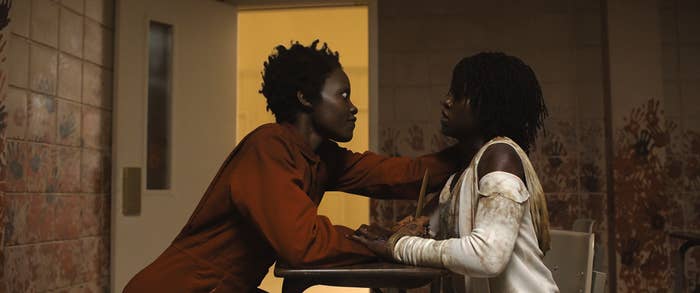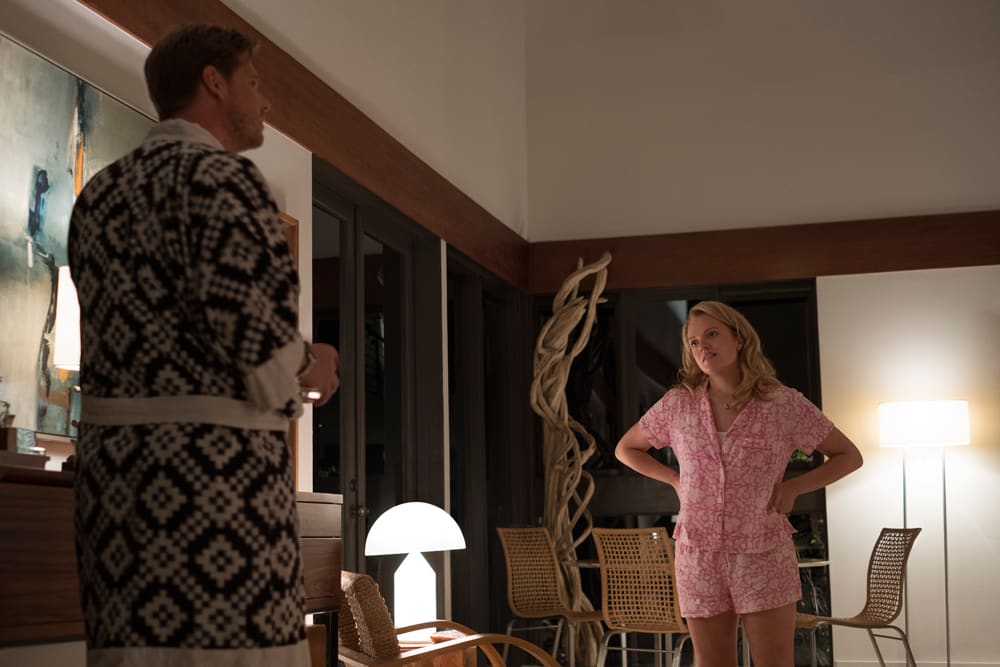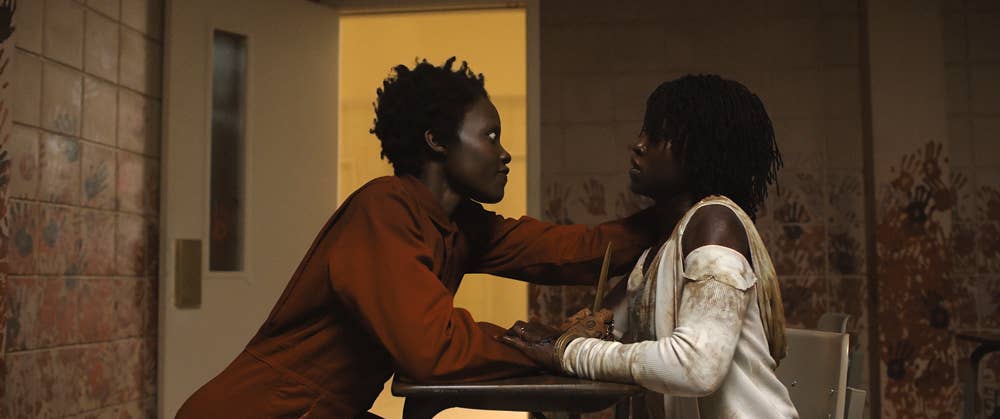
“Most of what you see is Lupita.”
That statement sums up Us overall, in which the Oscar-winning actress puts on a clinic pulling double duty as brave matriarch Adelaide, trying to lead her family to safety, and Red, her croaky, unsettling homicidal doppelgänger. But that comment comes from Mark Vaneslow, the film’s stunt coordinator, in specific regard to the Adelaide versus Red fight scene that serves as its climax.
Us leaves you with a lot to talk about. This is par for the course for a Jordan Peele joint, a director who, even at a grand total of two films under his belt, already commands the post-release discourse. His movies are loaded with motifs, double-meanings, and allegories designed to be unpacked and debated across group chats and Twitter theory threads. But Us is a different beast than Get Out, thematically but also technically. With a budget five times that of his seminal debut (look at that Oscar clout at work!) and a premise ripe to have some movie magic fun with, the questions raised after the credits roll aren’t just “What did that mean?” but also “How did they do that?”
You know the scene I’m talking about in particular. (And if you don’t that means you didn’t watch the movie yet which means you shouldn’t have even opened this post because SPOILERS.) In the climax, Adelaide and Red—who seems to be nursing rage-fueled envy towards Adelaide more heightened than the other Tethereds and their doubles—come to blows in the Tethered subterranean lair. Watching two Lupitas duke it out would be trippy unto itself, but Peele adds a second layer to the scene by cross-cutting between their fight and a very pivotal ballet recital they shared as young girls, in a manner in which the brawl itself becomes balletic.
In a movie with two home invasions, an explosion, and a scuffle on a speeding boat, Adelaide versus Red is, from a technical standpoint, at least, the crown jewel of the film, and Peele, Nyong’o, and Vaneslow prepped for it as such. “We knew it had to be special, and we started working on it before we started filming, working on the fight and the choreography,” Vaneslow says. “We worked on it throughout the whole movie, and then we shot it towards the end.” Films aren’t always shot sequentially, of course, but in this case, the schedule helped: “We needed all that time to develop what was going to happen.”

In that window leading up to filming, the scene continued to evolve as well. “A lot of those things factor into the final choreography. It seems obvious, but there are little things that make a huge difference,” Vaneslow explains. “How big is the classroom? What do the desks look like? All those kinds of things play a part. Once that’s finished and you get to actually rehearse on the actual set, a bunch of things change again. People get ideas.” Both Peele and Nyong’o voiced ideas and contributed to the developing rhythm of the scene. “By being able to work with Lupita in advance,” Vaneslow says, “we created with everybody’s input what would work the best for the character, for her, Jordan's vision, and what we could do safely. It was a lot of fun.”
Of course, when discussing the movie magic at hand, Vaneslow couldn’t pull the curtain back completely. But one of the more surprising things he revealed is that the production didn’t just employ one stunt double for each actor as is the norm, but two: “We had multiple doubles for each of the characters, particularly Winston and Lupita, so that one double could learn the one character and one double could learn the other character, [for] when she switched back and forth.” Still, don’t get it twisted: Even with doubles of doubles on set, that’s Lupita Nyong’o in the majority of the Red-Adelaide battle. “If you’re using regular filming styles, it just happens to be one actor, but you’re shooting the two actors,” Vaneslow says of the typical actor-stunt-double process. “It was never, like, she will do one person and then a stunt double will do the other. She would do it all with herself.”
When it was finally time to shoot, the entirety of the scene took only two days, a supreme feat of efficiency, all things considered. Vaneslow is quick to note the pains the trio and the rest of the crew took to pull it off so quickly, though: “It took weeks and weeks and weeks and weeks of rehearsal so that we could be efficient shooting it in two days.” Peele’s macabre flip of Luniz’s “I Got 5 on It” featured heavily in the film’s trailer, but its ties to the film didn’t end there—it scores the climax as well. However, if that was always Peele’s plan, it wasn’t something he shared with Vaneslow—which is to say, no, the scene wasn’t choreographed and coordinated around “I Got 5 on It” on set. “Sometimes the directors and producers don't necessarily articulate that because they don’t want everybody to know. Jordan may have always known which song his favorite was, but even in the one scene at [Elisabeth Moss and Tim Heidecker’s] house”—where they’re murdered to the starkly contrasting tune of “Good Vibrations”—“we didn't know exactly which of those songs were going to play in the final film.”

For Vaneslow—who worked with Peele previously on the much-less-stunt-driven Get Out—the action is the juice. He’s quick to highlight the difficulties of Us as fodder for more creativity than a headache, often conflating “challenge” with “fun” when he recalls his time on set. Take for example the way he recalls another high-energy scene, this one with Winston Duke versus his Tethered, Abraham: “The stuff on the lake, that was a blast. That was challenging to figure out. Winston was a champion and worked really hard with the boat and all those other [aspects] of being on the water.” In that scene, Duke’s Gabriel figures out a way to defeat the Tethered in the course of their fight, which, for Vaneslow, is the whole point of stunt choreography. “I come from a standpoint of really trying to build story-driven action, and action that’s suited for the performer, as opposed to ‘this would look really cool, but it’s not built around the person doing it.’”
Debate and awe aren’t the only conversations coming out of Us. Fans are also wondering if the Academy will deem Lupita’s performance as, once again, Oscar-worthy even though they’ve famously snubbed great work from respected actresses in the culturally less-respected genre of horror just as recently as last year, with Toni Collette and Hereditary. Vaneslow is pulling for her but also capitulates that it’s a long road to travel in that regard. “Watching her work, she definitely put the work in. I think that it's hard to even conceptualize and think about because it's such a large field and a lot of different people’s opinions go into that stuff. You never know how audiences grab onto things.”
It’s hard to imagine the masses not responding to it, with a reported $70 million box office haul and even the middling reviews pausing to praise Lupita’s work both technically and physically. Vaneslow is eagerly awaiting his chance to watch Us amid a crowd of civilians, but he saw the film at a cast-and-crew screening at the beginning of March. His reaction, watching the climax fully completed on the big screen? “Absolutely beautiful.”

